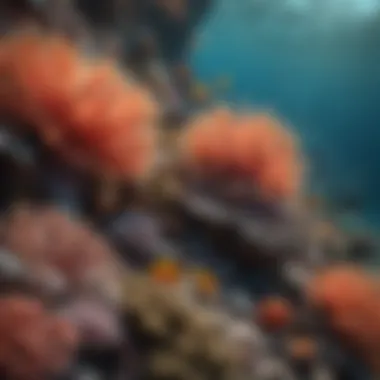Empowering Wildlife Preservation: Strategies to Aid Endangered Animals


Nature Topic Overview
There is an urgent need to delve into the realm of assisting endangered animals, exploring the critical importance of conservation efforts. Understanding the complexities of the ecosystem and the delicate balance of various species is crucial for preserving biodiversity and ensuring the survival of these vulnerable creatures.
Fun Facts and Trivia
Delving into the world of endangered animals reveals intriguing facts that not only captivate the minds of young readers but also serve as educational tools. From the astonishing speeds of cheetahs to the intricate social structures of elephants, these facts offer a glimpse into the wonders of the natural world. Interactive elements such as quizzes and puzzles further engage children, fostering a deeper connection with wildlife.
Wildlife Explorations
Embark on a journey to discover the diverse range of species that fall under the realm of endangered animals. Explore the unique characteristics of each species, from the majestic tigers prowling the jungles to the gentle giants like the whale shark swimming in the ocean depths. Learn about their habitats, behaviors, and the threats they face in their struggle for survival. Interactive features like species-specific quizzes enrich the learning experience, promoting curiosity and awareness.
Environmental Awareness
Instilling a sense of environmental consciousness is paramount in the conservation of endangered animals. Understanding the interconnectedness of ecosystems and the impact of human activities on wildlife habitats is key to fostering a culture of sustainability. Empowering children with tips on how they can contribute to nature conservation empowers them to make a positive difference, no matter how small.
DIY Nature Activities
Nurture a love for nature through engaging hands-on activities and experiments that children can enjoy from the comfort of their homes. Step-by-step guides for creating nature-inspired crafts using recyclable materials instill creativity and environmental awareness. Encouraging outdoor explorations, such as bird watching or plant identification, allows children to apply their knowledge and connect with the natural world on a personal level.
Understanding Endangered Animals
Definition and Classification
Critically Endangered Species
Critically Endangered Species represent the most vulnerable category facing the risk of extinction. These species are on the brink of disappearing from our planet, highlighting the urgency of conservation efforts. Their unique characteristic lies in the extremely low population numbers, making them highly susceptible to changes in their environment. Including a discussion on critically endangered species is paramount in emphasizing the dire need for immediate action to save these species from extinction. Despite their critical state, these species offer invaluable insights into the repercussions of human activities on the ecosystem.
Endangered Species
Endangered Species are those facing a significant risk of extinction in the near future if steps are not taken to mitigate threats. Their key characteristic is a substantial decline in population numbers, emphasizing the urgent need for conservation actions. Understanding the challenges confronting endangered species provides a glimpse into the fragile balance of our natural world. By highlighting the plight of endangered species, we aim to cultivate empathy and support for their protection and survival.
Vulnerable Species
Vulnerable Species represent a category of organisms that are at risk of endangerment under specific conditions. Their vulnerability stems from factors such as habitat loss, climate change, and human intervention. Discussing vulnerable species enriches our understanding of the complex interactions between various environmental factors and their impact on wildlife populations. Recognizing the state of vulnerable species prompts us to address the root causes of their endangerment and implement effective conservation strategies to ensure their survival.


Causes of Endangerment
Habitat Loss
Habitat loss stands as one of the primary drivers behind the endangerment of species worldwide. The destruction of natural habitats due to human activities such as deforestation and urbanization threatens the existence of numerous plants and animals. Addressing habitat loss is crucial in safeguarding biodiversity and promoting the coexistence of species within their ecosystems. Understanding the detrimental effects of habitat loss on wildlife underscores the imperative of preserving ecosystems for present and future generations.
Poaching and Illegal Wildlife Trade
Poaching and illegal wildlife trade pose significant threats to endangered species, driving many populations towards extinction. The exploitation of wildlife for commercial gains disrupts ecological balance and diminishes biodiversity. By examining the impacts of poaching and illegal trade, we can delineate the harmful consequences of these activities on wildlife populations. Combating poaching and illegal trade necessitates coordinated efforts at local and global levels to protect vulnerable species from exploitation and illegal trafficking.
Climate Change Impact
The impact of climate change on wildlife is becoming increasingly evident, affecting species across terrestrial, aquatic, and aerial ecosystems. Rising temperatures, habitat alterations, and extreme weather events constitute challenges that endangered species must contend with. Exploring the repercussions of climate change on wildlife populations elucidates the urgent need for sustainable practices and conservation initiatives. Mitigating the adverse effects of climate change requires collaborative actions aimed at reducing greenhouse gas emissions and enhancing wildlife resilience to environmental changes.
Importance of Conservation
Conservation is a crucial aspect discussed in this article focusing on the preservation of endangered animals. The essence of conservation lies in maintaining the delicate balance of ecosystems. By safeguarding endangered species, we uphold the intricate web of life on Earth. Conservation efforts not only protect individual species but also contribute to the overall health of ecosystems. It is imperative to realize that the importance of conservation extends beyond the animals themselves, playing a vital role in maintaining the planet's biodiversity and ecological stability. The significance of conservation efforts cannot be understated, as they are fundamental in combating the ongoing threats faced by endangered animals worldwide.
Ecosystem Balance
Role of Endangered Species
The role of endangered species in conservation efforts is paramount. These species serve as indicators of ecosystem health, reflecting the state of their surroundings. By focusing on preserving endangered species, conservationists can target key areas for habitat protection and restoration. Endangered species play a crucial role in maintaining ecosystem balance by contributing to crucial ecological functions. Their preservation is essential for ensuring the resilience and sustainability of ecosystems. Understanding the role of endangered species is vital in comprehending the intricate connections within ecosystems.
Impact on Biodiversity
The impact of endangered species on biodiversity is profound. Endangered species represent unique genetic resources that enrich the planet's biological diversity. Their presence enhances the stability of ecosystems, promoting resilience against environmental disruptions. By conserving endangered species, we protect the intricate web of life forms that collectively form biodiversity. The preservation of endangered species is crucial for sustaining the diverse array of organisms that coexist within ecosystems. Understanding the impact of endangered species on biodiversity underscores the need for comprehensive conservation strategies.
Ethical and Moral Considerations
Stewardship of Nature
Stewardship of nature is a fundamental ethical consideration in conservation efforts. It encompasses the responsibility humans have to protect and care for the natural world. By practicing stewardship of nature, individuals and communities can contribute to the preservation of endangered species and their habitats. This ethical approach emphasizes the intrinsic value of nature and advocates for a harmonious relationship between humans and the environment. Stewardship of nature fosters a deep appreciation for the interconnectedness of all life forms, instilling a sense of duty towards safeguarding biodiversity.
Interconnectedness of Life Forms
The interconnectedness of life forms underscores the interdependence of species within ecosystems. Every living organism plays a vital role in maintaining the balance of nature. Recognizing this interconnectedness highlights the profound impact each species has on its environment. By acknowledging the interconnectedness of life forms, conservation efforts can focus on preserving the diversity of species to ensure the resilience of ecosystems. Understanding the intricate relationships between different life forms is essential in developing holistic conservation approaches.


Ways to Help Endangered Animals
Raising Awareness
Educational Campaigns
Educational Campaigns serve as pivotal tools in disseminating vital information about endangered species and the threats they face. With a focus on increasing public knowledge and understanding, educational campaigns create awareness and foster a sense of responsibility towards wildlife conservation. The key characteristic of Educational Campaigns lies in their ability to educate diverse audiences, ranging from children to adults, on the importance of protecting endangered animals. This popular choice within conservation efforts aids in cultivating a society that values and actively participates in environmental conservation. Educational Campaigns uniquely engage with communities and schools to instill a sense of environmental stewardship and comprehend the consequences of inaction. This proactive approach bolsters awareness levels and encourages sustainable practices to mitigate human impacts on wildlife habitats.
Social Media Advocacy
Social Media Advocacy harnesses the power of online platforms to amplify conservation messages and reach a wider audience. By leveraging social media channels, conservation organizations and individuals can raise awareness on a global scale and mobilize support for endangered species. The key characteristic of Social Media Advocacy lies in its ability to disseminate information rapidly and engage with a diverse demographic. This digital strategy is a beneficial choice for this article as it bridges geographical barriers and promotes a collective voice for wildlife conservation. Social Media Advocacy's unique feature lies in its interactive nature, enabling direct communication between advocates and the public. While advantageous in its wide reach and immediate impact, Social Media Advocacy may face challenges related to misinformation spread and maintaining consistent engagement over time.
Supporting Conservation Organizations
Donations and Fundraising
Donations and Fundraising form a vital aspect of supporting conservation organizations dedicated to safeguarding endangered animals. By contributing financial resources, individuals and groups provide essential funding for conservation projects, research initiatives, and habitat protection. The key characteristic of Donations and Fundraising is its ability to generate substantial support and mitigate financial constraints within conservation efforts. This beneficial choice for the article enables individuals to make tangible contributions towards saving endangered species. Donations and Fundraising uniquely offer a direct means of support, allowing donors to see the impact of their contributions through conservation outcomes. While advantageous in securing essential funding, these initiatives may face disadvantages such as donor fatigue and unequal distribution of financial resources.
Volunteer Opportunities
Volunteer Opportunities provide an avenue for hands-on engagement and direct involvement in conservation efforts. By volunteering time and skills, individuals contribute to wildlife conservation through fieldwork, research activities, and community outreach programs. The key characteristic of Volunteer Opportunities is the active participation and dedication of volunteers towards conserving endangered species. This popular choice within conservation initiatives empowers individuals to make a tangible impact and gain firsthand experience in wildlife protection. Volunteer Opportunities uniquely offer a sense of fulfillment and connection with nature, fostering a deeper understanding of conservation challenges and solutions. While advantageous in promoting active engagement, volunteer programs may encounter challenges in recruitment and resource management.
Promoting Sustainable Practices
Responsible Tourism
Responsible Tourism advocates for ethical and sustainable travel practices that prioritize wildlife conservation and environmental protection. By promoting responsible tourism, individuals can minimize their ecological footprint and support conservation efforts in fragile ecosystems. The key characteristic of Responsible Tourism is its focus on sustainable tourism principles that reduce negative impacts on wildlife habitats and local communities. This beneficial choice within the article encourages travelers to make conscious choices that benefit both biodiversity and cultural heritage. Responsible Tourism's unique feature lies in its capacity to educate tourists on ethical behavior and promote conservation-minded travel experiences. While advantageous in fostering environmental awareness and supporting local economies, Responsible Tourism may face challenges such as greenwashing and ensuring industry compliance with sustainable practices.
Ethical Consumerism
Ethical Consumerism advocates for conscious purchasing decisions that prioritize environmentally friendly and cruelty-free products. By choosing ethically produced goods, individuals contribute to sustainable supply chains and reduce demand for products that harm wildlife and ecosystems. The key characteristic of Ethical Consumerism is its emphasis on environmentally conscious consumption patterns that support wildlife conservation efforts. This beneficial choice for the article underscores the significance of consumer choices in promoting responsible environmental practices. Ethical Consumerism's unique feature lies in its potential to drive market demand towards sustainable and ethical products, encouraging businesses to adopt eco-friendly practices. While advantageous in promoting sustainable consumption habits, Ethical Consumerism may encounter challenges related to affordability and limited market availability of ethical products.
Impact of Human Activities on Wildlife
Human activities have a significant impact on wildlife. In the context of this article, understanding the Impact of Human Activities on Wildlife is crucial for raising awareness about the challenges faced by endangered species. It sheds light on the various factors contributing to habitat destruction and pollution, highlighting the urgency of conservation efforts to mitigate these threats.


Urbanization and Habitat Destruction
Deforestation
Deforestation, a key component of urbanization, plays a pivotal role in habitat destruction. The extensive clearing of forests for agricultural, industrial, or residential purposes disrupts ecosystems, leading to habitat loss for wildlife. The accelerated rate of deforestation poses a severe threat to biodiversity, emphasizing the need for sustainable land management practices to conserve natural habitats.
Urban Expansion
Urban expansion amplifies the pressures on wildlife habitats, as city infrastructures encroach upon natural landscapes. The rapid growth of urban areas results in habitat fragmentation, restricting animal movements and gene flow. This expansion further accelerates deforestation and disrupts ecological balances, underscoring the importance of urban planning that integrates conservation considerations to safeguard wildlife habitats.
Pollution and Its Consequences
Water Pollution
Water pollution poses a grave threat to aquatic ecosystems and the species dependent on them. Contamination from industrial discharge, chemical runoff, and plastic waste harms aquatic biodiversity, affecting both marine life and freshwater organisms. Addressing water pollution requires stringent regulations and collaborative efforts to preserve water quality and protect vulnerable species inhabiting these environments.
Air Pollution
Air pollution adversely impacts both terrestrial and aquatic wildlife, posing health risks and altering ecosystems. Emissions from vehicles, industries, and deforestation activities introduce harmful pollutants into the atmosphere, leading to respiratory issues and habitat degradation. Mitigating air pollution involves adopting cleaner technologies, reducing emissions, and promoting sustainable practices to safeguard wildlife and their habitats.
Case Studies of Successful Conservation Efforts
In this pivotal section focusing on case studies of successful conservation efforts, we delve deep into practical examples that highlight the impact of dedicated initiatives. These case studies play a crucial role in showcasing tangible outcomes and inspiring further action in the realm of wildlife preservation.
Panda Conservation in China
Efforts by Conservation Organizations
Examining the efforts put forth by conservation organizations reveals a meticulous approach towards safeguarding the endangered panda population in China. These organizations display a unique dedication to habitat preservation, anti-poaching measures, and community engagement. Their strategic conservation tactics emphasize a holistic conservation approach that addresses both the immediate and long-term needs of pandas. This focus on comprehensive protection strategies sets a beneficial precedent for similar conservation endeavors worldwide.
Government Support
Underlying the success of panda conservation in China is the substantial government support extended towards conservation initiatives. By providing essential resources, legislation, and enforcement mechanisms, the government plays a pivotal role in securing the habitats crucial for panda survival. This unwavering support fosters a conducive environment for collaboration between governmental bodies and conservation organizations, enhancing the effectiveness of conservation efforts. Despite certain challenges, such as bureaucracy and budget constraints, government support remains a fundamental pillar in the ongoing success of panda conservation efforts.
Sea Turtle Protection in Costa Rica
Community Involvement
The involvement of local communities stands out as a cornerstone of sea turtle protection in Costa Rica. Community engagement initiatives have empowered residents to actively participate in conservation activities, ranging from beach clean-ups to nesting site monitoring. This grassroots involvement not only raises awareness about the importance of sea turtle conservation but also instills a sense of stewardship among community members. The collaborative efforts between conservation groups and local residents exemplify a symbiotic relationship that underscores the significance of community-driven conservation practices.
Research Initiatives
The emphasis on research initiatives underscores the scientific foundation of sea turtle protection in Costa Rica. By employing cutting-edge research methodologies, scientists gather valuable data on sea turtle behavior, migration patterns, and population dynamics. This scientific knowledge forms the basis for targeted conservation strategies that address specific threats faced by sea turtles. Research initiatives not only enhance the understanding of sea turtle ecology but also inform practical conservation measures aimed at mitigating human-induced impacts on these majestic marine species.







